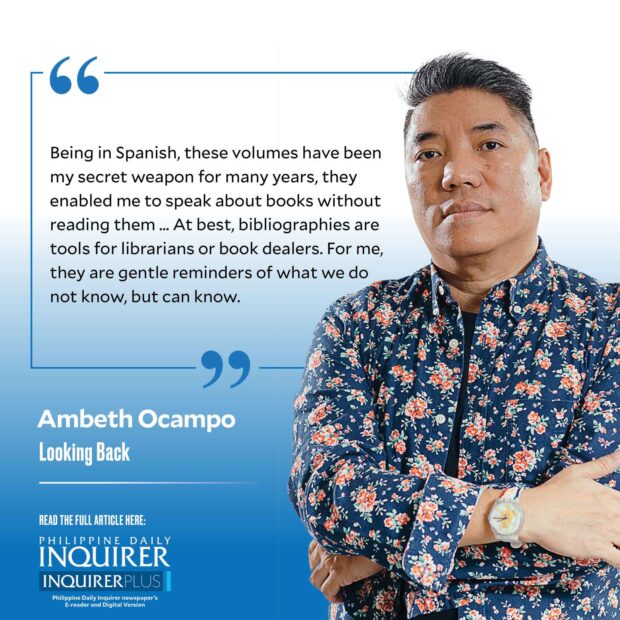How to talk about books you haven’t read
Of the many skills deployed by historians, one of the most useful is being able to talk about books they have never read. One could add to this, books they have not even physically handled. How do they do that?
Historians map out the terrain of their field of specialization through bibliographies. These are hefty, often boring, bibliographic listings of books on a given field or topic. Nobody I know reads these anymore. They seem old fashioned or “jurassic” to a generation that draws information online faster than you can spell b-i-b-l-i-o-g-r-a-p-h-y. I look back on bibliographies as the Philippine Book Festival runs in Davao this weekend. Organized by the National Book Development Board, I have two events: a book signing, and a conversation with National Artist Resil Mojares on the books we have read that have changed our lives.
The first bibliography I ever owned was the two volume “Union Catalog of Philippine Materials” by Maxima Ferrer (1970). These were languishing in the bargain bin of the University of the Philippines (UP) Press for P10 in the mid-1980s. Over a thousand pages, printed on book paper and hard bound, interior designers could use them to populate empty shelves. Aside from home décor, these could also serve as door stoppers. Nobody wanted them. When I went to the cashier to pay, she gave me a sorry look and asked: “Why are you wasting your money on these?” I bought two sets, one to use, the other as a spare. At first glance, these were simply printed card catalogue entries gathered from the major libraries in Manila: National Library, UP, University of Santo Tomas, Ateneo libraries, Lopez Museum, etc. By consulting Ferrer, I knew exactly where the physical books I needed were located, their dimensions, number of pages, imprint dates etc. Bibliographies were a map of the terrain, that helped me track down leads to the past.
Armed with 12 units of college Spanish, I graduated from Ferrer’s simple English listing to the three important, annotated, Philippine bibliographies: José Toribio Medina’s “Bibliografia Española de las islas Filipinas (1523-1810)” (A Spanish bibliography of the Philippine Islands, 1523-1810) published in Santiago de Chile in 1898; Trinidad H. Pardo de Tavera’s “Biblioteca Filipina O Sea Catálogo razonado de todos los impresos, tanto insulares como extranjeros, relativos á la historia, La Etnografía, La Lingüística, La Botánica, La Fauna, La Flora, La Geología, La Hidrografía, La Geografía, La Legislación, etc., de las Islas Filipinas, de Joló y Marianas” (Philippine Library or a Reasoned Catalog of all the imprints both local as well as foreign publications relating to the History, Ethnography, Linguistics, Botany, Flora, Fauna, Geology, Hydrography, Geography, Legislation, etc. of the Philippine Islands, of Jolo and the Marianas) published in Washington in 1903; and, last but not least, the most impressive being Wenceslao Emilio Retana’s three-volume “Aparato bibliográfico de la historia general de Filipinas: deducido de la colección que posee en Barcelona la Compañia general de tabacos de dichas islas,” (Bibliographic Apparatus of the General History of the Philippines based on the collection of the General Tobacco Company of these islands kept in its headquarters in Barcelona), published in Madrid in 1906.
Except for Pardo de Tavera, that was only reprinted in 1994, Medina and Retana were readily available having been reprinted, earlier, in the 1960s. Pedro B. Ayuda reprinted a very luxurious edition of Retana’s “Aparato” in 1964 that probably contributed to his financial ruin. Searching for a set of Retana’s “Aparato,” I was dismayed to find Ayuda’s bookshop on Recto avenue padlocked with a sign from the Manila sheriff’s office regarding a sale of everything within the premises. I didn’t give up and found Ayuda at home in Quezon City, an eccentric who was the proud president of the Philippine Bar Flunkers Association!
Medina, Retana, and Pardo de Tavera provided more than a physical and bibliographic description of all early books on the Philippines. The bibliographers provided erudite annotations on each book: an outline of the contents and its importance to Philippine history; notes on the author and his credibility compared to other authors, etc. Title pages and important illustrations from the rarest of volumes were reproduced by Retana.
Being in Spanish, these volumes have been my secret weapon for many years, they enabled me to speak about books without reading them. This is not a bad thing because not all books have to be read cover to cover. Some books are read for reference or information, some for pleasure. Others are just decoration on our shelves, to impress visitors who don’t read as much. At best, bibliographies are tools for librarians or book dealers. For me, they are gentle reminders of what we do not know, but can know.
—————-
Comments are welcome at aocampo@ateneo.edu






















